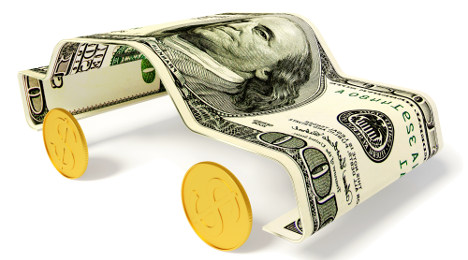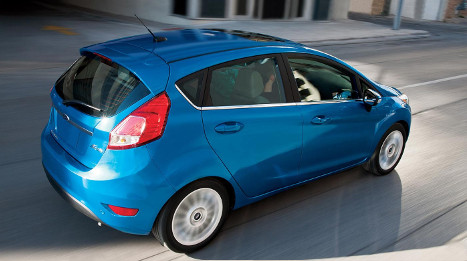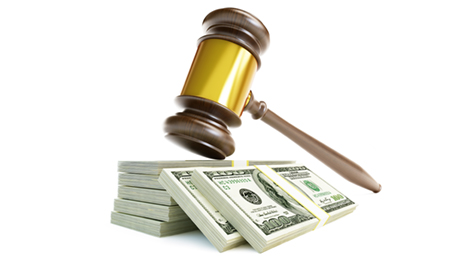Though depreciation slowed a little bit last week, the auction market is still seeing prices decrease at a rate larger than normally seen during tax season, which traditionally brings rate strength to the lanes.
Most trucks, of course, are continuing to see stronger price trends than cars, with the exception of full size luxury utilities and full-size vans, according to the latest Black Book Market Insights report.
And auction attendees are feeling the seasonal trend shifts, as well. Black Book overheard a buyer from New Jersey say last week, “The market trend in this area is still a little slow with everyone waiting on that spring market bump in action.”
Overall, car values fell by an average of 0.23 percent or $23 last week. And although this may seem slight, in comparison car values increased by 0.02 percent during the same week last year.
“Midsize cars and subcompact crossovers showed slight increases in prices, indicating consumer demand for these segments in this tax season over other segments,” said Anil Goyal, vice president of automotive valuation and analytics.
The midsize, compact and subcompact car segments performed the best out of the lot. The midsize cars saw an increase of 0.04 percent, while the midsize cars (down by 0.13 percent) and subcompact cars (down by 0.19 percent) saw slight decreases.
The worst performing car segment last week was the sporty car segment, which experienced a drop of 0.58 percent or $83.
Truck prices overall dropped by an average of 0.31 percent or $45 last week, according to Black Book data. For year-over-year comparison, truck values fell by only 0.02 percent during the same week of 2015.
Subcompact crossover and compact van segments performed the best out of the truck segment, with increases of 0.33 percent and 0.09 percent, respectively.
On the other hand, full-size vans took the biggest percentage hit among the trucks with a decline of 0.89 percent or $111.
February represented the steepest drop in wholesale prices (on a mix-, mileage- and seasonally adjusted basis) in over three years, according to comments accompanying the latest Manheim Used Vehicle Value Index published on Monday.
The index’s reading for February was 123.3, down 1.4 percent year-over-year. Of the six vehicle segments included in the report, five showed price declines.
Compact car values fell 10.7 percent year-over-year, midsize cars were down 1.9 percent and luxury cars dipped 2.1 percent. SUV/CUV and van values were each off 1.7 percent.
Pickups were the lone segment to show an increase (7.4 percent).
In his commentary on the index, Cox Automotive chief economist Tom Webb explained the likely impact of such a decline, which has been rare these past few years of historically high used-car values.
“February’s relatively steep decline in wholesale pricing — remember seasonally adjusted (prices were up before the adjustment) — resulted in the Manheim Index’s falling back to its long-term trend line,” Webb said in the report.
“Given that the Index has been above-trend for 66 of the past 72 months, look for an extended reversal to cause lenders and lessors to reassess collateral risk and contract residuals,” he said. “We expect the adjustments will be modest, however, and, thus, the availability of retail financing will remain supportive to the used-vehicle market in the near term.”
For an extensive analysis from Webb on the used-car market and beyond, be sure to tune into this free webinar at 2 p.m. (ET) Tuesday.
Webb will provide his unique perspective on the many facts and figures highlighted throughout Manheim’s 2016 Used Car Market Report and the impact they will have on the automotive industry in 2016 and beyond.
In a review of the data and trends shaping the used car business, Webb will present an in-depth analysis of current vehicle data and market conditions as well as the expectations of the future economy.
Attendees will also have an opportunity to interact with Webb during a live Q&A. If you have some questions for Tom ahead of time, send them to joverby@autoremarketing.com or tweet them to @AR_JoeOverby.
Need ideas? Manheim's 2016 Used Car Market Report may provide some thought-starters.
Though depreciation had slowed a bit at the start of the year, wholesale depreciation is now continuing at a steady pace, and the industry isn’t seeing much of the usual tax season strength. This is true especially for some of the smaller car segments, which are seeing significant price drops.
According to the latest Black Book Market Insights report, the car segments dropped by an average of 0.53 percent or $53, while trucks dropped by 0.42 percent or $62 last week.
Commenting on the market’s performance in an analysis, Anil Goyal, vice president of automotive valuation and analytics at Black Book, said, “The used-vehicle market continued to decline at a steady pace, not showing signs of any tax refund season strength yet.”
Auction attendees echoed that sentiment in the lanes. Black Book editors overheard an auction attendee from Pennsylvania say, “The market seems a little off today. Bidding and sales were just a bit sluggish,” while another buyer from Tennessee said, “Large SUV sales were slow this week in this location.”
And Black Book pointed out, “Average weekly depreciation rates are higher in 2016 in comparison to 2015 for the month of February across all primary car segments that get attention during the tax refund season.” This includes the full-size, compact, midsize and subcompact car segments.
The car segments’ decline last week was higher than the average depreciation rate of 0.38 percent seen over the previous two months.
Among the cars, the subcompact and compact categories took the biggest hits last week. The subcompact segment dropped by 1.06 percent or $62, while the compact cars fell by 1.07 percent or $75. The best performing car segments were the midsize and sporty cars, which both fell by just 0.14 percent, on average.
Truck depreciation has picked up, as well, after staying relatively mild throughout much of 2015. In fact, last week’s price drop is slightly higher than the average depreciation rate of 0.39 percent seen over the prior eight weeks.
That said, a couple of truck segments actually saw prices rise last week. The full-size crossover/SUV segment rose by 0.08 percent or $14 last week, while the full-size vans saw a slight rise of 0.06 percent or $8.
On the other hand, the small pickup and compact luxury crossover/SUV segments dropped the most out of the trucks, with declines of 1.19 percent and 0.82 percent, respectively.
Last week in the lanes brought continued strength in the majority of the car segments, save for one: the subcompact cars. And among the trucks, the full-size pickups experienced some softness this past week.
Although the subcompact car segment had been recovering a bit from 2015 lows, it experienced a significant price decline last week, according to the latest Black Book Market Insights report.
That said, the report stated overall cars are picking up steam in the lanes, and that dealer sentiment “mirrors this trend.” Black Book editors are overhearing dealers say prices are holding steady, and trucks are seeing more no sales — both of which are trends expected around tax season.
Car values fell by 0.33 percent or $33 last week, while truck prices dropped by 0.47 percent or $69.
“Overall used-vehicle values continued to decline at a steady pace similar to the last six weeks. Interestingly, subcompact car values dropped sharply after two weeks of strength,” said Anil Goyal, vice president of automotive valuation and analytics.
The overall average drop in car prices is slightly lower than the average depreciation rate of 0.40 percent seen over the previous six weeks, according to Black Book data.
As aforementioned, the subcompact segment took the biggest hit, with prices dropping by 0.86 percent or $51. The prestige luxury car and sporty car segments also took hits, with average price drops of 0.65 percent and 0.59 percent, respectively.
The best performing segment for the cars was the near-luxury car category, which saw prices drop by a slight 0.15 percent or $27.
The truck decline seen last week was slightly higher than the average depreciation rate or 0.38 percent seen over the previous two months, Black Book editors pointed out.
The compact commercial van, minivan and full-size pickup segments saw the biggest declines last week among the trucks, with prices dropping by 1.26 percent, 1.06 percent and 0.98 percent, respectively.
Two truck segments even saw prices increase last week. The subcompact crossover segment experiences a 0.27-percent or $33 rise in prices, while the compact luxury crossover/SUV category saw a 0.05-percent or $9 gain.
There’s a term that Tom Kontos had for January’s wholesale market that he doesn’t often get to chance to use.
And hey, let’s admit it, the word is actually kind of fun to say.
“Bifurcated.”
For those without Dictionary.com saved on your browser, the adjective form of the word means “divided into two branches,” according to the site.
In his latest video report, Kontos — chief economist at ADESA Analytical Services — found it to be an apt modifier, “because the wholesale was actually split into two markets: the market for trucks, which was strong, and the market for cars and crossovers, which was relatively soft.”
And he points to this as proof: Prices fell in every single car and crossover segment on a year-over-year basis in January. Meanwhile, prices climbed for all but one truck segment (minivans), he said.
Low gas prices continued to push truck values, as did the fact that both supply for and cash incentives on trucks have come down, Kontos said in the video. Meanwhile, supply and dealer discounting on cars and crossovers has been higher.
The full Kontos Kommentary video can be viewed above or at blog.adesa.com/video-kontos-kommentary-for-january-2016.
Prices in the lanes are holding stable as dealers buy up inventory in preparation for tax refunds to start pouring into potential customers’ bank accounts.
Price depreciation at auction last week was very slight, according to the latest Black Book Market Insights report.
Car prices dropped by just 0.19 percent or $19, according to Black Book data, while trucks took a slight hit of 0.14 percent of $21.
“Nearly all segments exhibited stability in values and showing signs of continued buying ahead of tax refund season,” Anil Goyal, senior vice president of automotive valuation and analytics at Black Book, said in the analysis.
Comment from the lanes echoed that sentiment. Black Book editors overhear an auction attendee from Tennessee note, “Good tax sale today. Cars for less than $10,000 sold really well,” while a buyer form California said, “Strong sale with strong bidding today both on the floor and online.”
Prices have begun stabilizing over recent weeks, but the tides are really beginning to show signs of early spring selling season as February progresses.
The car segments average price drop of 0.19 percent was much lower than the average depreciation rate of 0.43 percent seen over the previous six weeks.
And for trucks, the 0.14-percent decline was a more positive showing than the 0.38-percent average decline seen over the previous two months.
Among the cars, the premium sporty car segment saw the biggest drop, in line with trends normally seen in the dead of winter, with rates dropping by 0.84 percent or $272. The subcompact car, compact car, midsize car and full-size cars segments “moved very little,” according to Black Book editors.
The subcompact segment, which saw significant depreciation over 2015 due in part to low gas prices, is now stabilizing a bit.
Among the trucks, the midsize crossover/SUV, full-size pickup and full-size luxury crossover/SUV segments saw the largest drops, of 0.28 percent, 0.25 percent and 0.22 percent, respectively.
The small pickup segment was the best performer out of the trucks, with prices rising by 0.19 percent or $12.
Used-car prices remain strong overall early in the year, but there is a caveat.
“In comparison to last year’s trends, the prices show a relatively higher depreciation of -2.3 percent in 2016 versus -1.5 percent in 2015 in the first six weeks of the year,” the report stated.
And as supply continues to expand, many analysts expects that trend to continue to put downward pressure on used prices.
In fact, the industry isn’t expected to see the usual boom in price strength during tax season, though rates are expected to remain elevated for the spring selling season.
“Coinciding with the steady receipt of tax refund checks, used vehicle prices gradually improve over a given first quarter before tapering off as spring progresses,” Jonathan Banks, executive automotive analyst at NADA Used Car Guide, said in the January Guidelines report. “While we expect a similar pattern to play out over the next few months, we believe higher supply will dampen this year’s Q1 rise.”
As the industry gears up for the early-spring selling season, depreciation is slowing down, per historical trends.
According to the latest Guidelines report from NADA Used Car Guide, wholesale vehicles prices were flat in January, falling by only 0.1 percent from December.
That said, while the change was slight, January’s decline was slightly worse than the 0.3-percent rise averaged over the past five years.
As for what NADA UCG expects to happen this year, used prices are expected to rise by an average of 1 percent in February and then by an additional 2 to 2.5 percent in March. This month, mainstream segment prices are expected to rise from 1 to 1.5 percent, while luxury segment prices should remain essentially unchanged.
In January, NADA UCG’s seasonally adjusted used vehicles prices index fell, dropping by 0.3 percent month-over-month to 122.2. For comparison, the index was at 125.4 last January, which is 2.6 percent above this past month’s numbers.
“Typical for January, luxury segment depreciation led the industry, while mainstream losses were mild,” Jonathan Banks, executive automotive analyst at NADA UCG, said in the report.
Luxury large cars led the pack with the biggest depreciation rate, with prices down by 3.2 percent. Banks pointed out this depreciation outpaces the segment’s previous five-year average of 2.4-percent depreciation.
“Losses across other luxury segments were more in line with what is typically seen this time of the year, however, the group’s collective 1.6-percent drop was slightly more aggressive than the 1-percent decline averaged since 2011,” he shared.
Taking a look at mainstream vehicles, subcompact car prices saw the biggest price drops one again with prices falling by 0.8 percent
“Prices for the segment are typically flat-to-up (slightly) during January,” Banks said.
This segment might be making a comeback as we move into early spring, according to Black Book data.
According to the latest Black Book Market Insights report, the subcompact cars even saw prices increase last week, with rates rising by 0.03 percent or $2. This was the only car segment to see any increase last week in the lanes.
Moving on to highlight truck price movement reported in the latest Guidelines issue, large pickup and compact utility prices dropped by 0.6 percent and 0.4 percent, respectively, which the report said is normal for the first month of the year.
Price drops for the remaining segments in January were less than 0.5 percent, according to NADA UCG data, except for one: midsize pickups actually saw a 0.5-percent spike in prices last month.
With gas prices low, and many consumers turning toward larger vehicles, the compact and subcompact segments suffered some pretty significant depreciation in 2015. But as we approach tax season, the early spring period is bringing with it a strengthening in values for many of these segments.
According to the latest Black Book Market Insights report, the subcompact cars even saw prices increase last week, with rates rising slightly by 0.03 percent or $2. This was the only car segment to see any increase last week in the lanes.
“The subcompact car segment started to show strength with tax season approaching. In addition, most crossover/SUV segments remain relatively strong,” said Anil Goyal, senior vice president, operations at Black Book.
Overall car values dropped by 0.47 percent or $47 last week, which is close to the average depreciation rate of 0.44 percent seen over the prior eight weeks, while the truck segments dropped by just 0.20 percent or $30. For the trucks, this number is significantly lower than the average rate of decline of 0.49 percent seen over the previous two months.
Among the car segments, all declined in value, except for the aforementioned subcompact's upward movement. The midsize car segment has the largest change of the week with a decline in price of 0.69 percent or $59. This segment was followed by the full-size cars, which saw prices drop by 0.60 percent or $55.
Among the truck segments, Black Book editors said that industry professional need to take a close look at trends surrounding the subcompact crossover segment. Interestingly, full-size crossover/SUV and compact van segments were on the way up last week in terms of price, but the subcompact crossover segment experienced a drop of 2.4 percent or $258.
This, too, could be related to gas prices, as average fuel prices sit around $2 per gallon, consumers are willing to shell out more for a full-size SUV. The full-size/crossover SUV segment saw prices rise by 0.19 percent or $33 last week.
According to Black Book, the average price of a used-vehicle for model years 2010-2014 dropped 1.6 percent last month, and full-size SUVs continued to lead all the segments with the strongest price retention in January, with rates dropping by just 0.3 percent.
On the other side of the spectrum was this trend: For the second month in a row, subcompact luxury CUVs saw the highest depreciation last month with vehicles dropping by 4 percent. The segment ended the month with an average price of $17,314, which is down 21 percent from January 2015.
“For the third straight month we have seen the lowest depreciation of all segments in full-size crossover/SUVs,” said Goyal. “This trend, combined with continued low gas prices, is a sign that larger vehicles may continue to demonstrate relative strength in their value throughout this year.”
Save a few outliers, it seems tax season is beginning to push value strength at auction, and dealers are feeling the impact in the lanes.
Black Book editors overheard an auction attendee from Arizona say last week, “A very good sale here today with prices holding strong on many segments,” while another buyer from Pennsylvania stated, “Really good sale here today with around a 70 percent sales rate.”
Vehicles prices at auction fell a bit in January, but depreciation remains low — and analysts expect this trend to continue through the spring and tax season. And price retention is particularly strong in the full-size SUV segment, as gas prices remain unusually low.
According to Black Book, the average price of a used-vehicle for model years 2010-2014 dropped 1.6 percent last month.
Specifically, cars saw prices drop by 1.7 percent in January, while trucks dropped by 1.5 percent for the month.
Full-size SUVs continued to lead all the segments with the strongest price retention in January. Prices only dropped by 0.3 percent last month for the full-size SUVs, perhaps due in part to dropping fuel prices. The segment finished the month with an average price of $25,063, which is down 1.7 percent year-over-year.
“For the third straight month we have seen the lowest depreciation of all segments in full-size crossover/SUVs,” said Anil Goyal, senior vice president, operations for Black Book. “This trend, combined with continued low gas prices, is a sign that larger vehicles may continue to demonstrate relative strength in their value throughout this year.”
On the other side of the spectrum was this trend: For the second month in a row, subcompact luxury CUVs saw the highest depreciation last month with vehicles dropping by a significant 4 percent. The segment ended the month with an average price of $17,314, which is down 21 percent from January 2015.
One other segment also saw depreciation pass 3 percent: the compact vans. This segment’s prices dropped by 3.6 percent in January to finish the month with an average price of $10,101, which is down 22.8 percent year-over-year.
Here is how the pricing for January broke up by domestic and foreign automakers, according to Black Book data:
- Domestic car prices dropped by 1.4 percent on a monthly basis.
- Domestic truck prices fell by 1.3 percent from December rates.
- Import car prices were down 1.9 percent in January.
- Import truck rates fell by 2 percent last month.
Wholesale used-vehicle prices technically softened in January, marking only the second decline in the past eight months, to leave the Manheim Used Vehicle Value Index at 125.2 — virtually unchanged from a year ago.
But Cox Automotive chief economist Tom Webb pointed out that a straight average of all auction sales in January showed wholesale prices ticking up nearly 2 over the past year and moving almost 8 percent over the past three years.
Webb explained this over-performance relative to the Manheim Index reflects the movement upscale in the market class of vehicles being sold, and the shift toward more late-model, lower-mileage vehicles being offered in the wholesale market.
Turning back to the index data, Webb again offered more clarity about the January trends, which also showed prices for pickups jumping 8.5 percent while prices for compacts tumbling by 8.9 percent.
“Wholesale pricing for minivans has eased noticeably in recent months, but firm valuations for full-size cargo units kept the total van category up year-over-year in January,” Webb said about pricing for the segment nudging up 0.8 percent.
“Pickups, both midsize and full-size, remain the strongest segment in recent months and over the past year. Within the SUV/CUV category, full-size units have far outperformed the other subcategories,” he continued.
“In January, compact cars remained the weakest of the major categories, with a year-over-year decline of near 9 percent,” Webb went on to say. “Luxury cars — and all of the subcategories in that segment — have also underperformed the market over the past year.”
Webb acknowledged it has been long anticipated that wholesale values would ease in 2016 as a result of higher supply.
“We suspect the first downward movement of the year was more the result of past margin compression than growing wholesale volumes,” he said about the index reading that actually ticked 0.1 percent lower.
“Retail used-vehicle gross margins were not strong in the fourth quarter of last year, so it is only logical that dealers will moderate their bidding until such time as the risk-reward ratio comes back into better alignment,” Webb added.
January retail sales: Steady, but unspectacular
Rounding up to 17.6 million, Webb noted the seasonally adjusted annual selling rate for new vehicles in January once again “beat” expectations. But he added this achievement came with more than a single note of caution.
“January’s sales pace is always sensitive to the seasonal adjustment factor — one which this year was further complicated by the adjustment for two fewer selling days,” Webb said.
“Many think that even a one-day adjustment is a rather quaint notion that ignores reality and common business practices,” he continued.
On a three-month moving average basis, Webb calculated the new-model SAAR was 17.6 million in January versus a high of 18.1 million in November.
“In any event, one thing is clear: Adjusted or unadjusted, retail sales were down and incentive spending was up in January relative to a year ago,” Webb said.
Webb also mentioned total fleet purchases rose 14 percent in January with sales into rental up more than 13 percent, commercial deliveries up 9 percent, and government purchases up more than 30 percent.
The Cox Automotive economist went on to mention preliminary numbers suggest that total used vehicle sales were able to eke out a small gain in January (without the aid of a selling day adjustment). But as reported by Auto Remarketing, CPO sales in January declined 2.1 percent.
“Granted, there is no selling-day adjustment,” Webb said. “But even if there were, the resulting increase would be small compared to the large percent gains posted in each of the last three years.”
Update on rental risk pricing
Also of note in the latest Manheim index report, Webb mentioned prices of off-rental units remain steady.
In January, auction prices for rental risk units (adjusted for broad changes in mix and mileage) declined 0.6 percent from December and softened by 3.3 percent from a year ago.
“Overall, however, this price series has remained in a very narrow range for more than five years,” Webb said.
“Unadjusted prices set a new January high, based in part on a 7.6 percent decline in average mileage from a year ago,” he continued. “Auction volumes for rental risk units were down in January relative to last year.”












